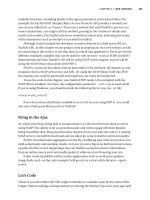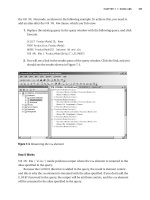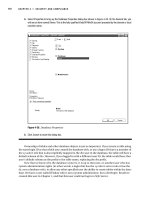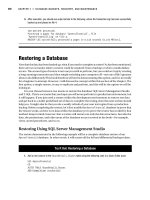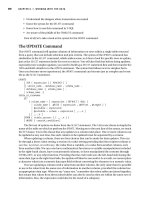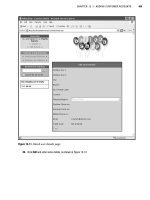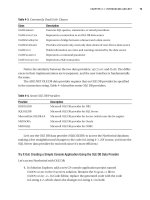Virtual Art From Illusion to Immersion phần 8 ppsx
Bạn đang xem bản rút gọn của tài liệu. Xem và tải ngay bản đầy đủ của tài liệu tại đây (1.94 MB, 44 trang )
39. Vale
´
ry (1973), p. 47 (transl. O.G.).
40. Albert Borgmann, ‘‘Information, nearness, and farness,’’ in Goldberg
(2000).
41. Hubert Dreyfus, ‘‘Descartes’s last stand,’’ in Goldberg (2000), pp. 58ff.
42. Martin Jay, ‘‘The speed of light and the virtualisation of reality,’’ in
Goldberg (2000). See esp. note 55.
43. Lovelock (1979).
44. hwww.artcom.de/projects/t_vision/welcome.eni.
45. Davis (1998), p. 305.
46. ‘‘Das absolute Sehen (Gottes) . . . alle Scha
¨
rfe, Schnelligkeit und Kraft aller
tatsa
¨
chlich Sehenden und aller, die zu Sehenden werden ko
¨
nnen, u¨ bertrifft.’’
Nicholas of Cusa: ‘‘Vom Sehen Gottes,’’ in Gabriel (1967), vol. 3, pp. 93–219.
47. Ibid.
48. Ianka (1957).
49. Bolz (1993), p. 14.
50. Zec (1991), p. 112.
51. Loeffler (1992), p. 68.
52. Bolz (1993), p. 121.
53. See Bredekamp (1997b).
54. See Ascott (1997), p. 35.
55. See Haraway (1997).
Chapter 7
294
6641 FM UG 9/12/02 5:38 PM Page ii
This Page Intentionally Left Blank
9
8
Evolution
Genetic Art: Christa Sommerer and Laurent Mignonneau
The current renaissance of the classic alliance between art, technology, and
science has seen the rise to prominence of a number of artists who are also
affiliated with centers of scientific excellence. Two of the most important
contemporary media artists, Christa Sommerer and Laurent Mignonneau,
are representatives of this new alliance. Their works show at top interna-
tional festivals and exhibitions and are discussed and published worldwide.
Over 100 international exhibitions since 1992, when their collaboration
began, document Sommerer and Mignonneau’s public acclaim and success.
Christa Sommerer, from Austria, and Laurent Mignonneau, from France,
have received many international awards for their work,1 and extensive
press coverage has cemented their reputation. As scientists, they have lec-
tured at universities and international symposia and have authored many
research papers.
At an advanced technological level, Sommerer and Mignonneau’s work
engages with the upheavals wrought in contemporary art by the revolu-
tions in imaging media and bioscience. They pioneered the use of natural
interfaces that, together with artificial life, or ‘‘A-Life,’’ and evolutionary
imaging techniques, began a new chapter in the history of interactivity.
The ideas driving their art are impressive for the scope of their engage-
ment with the patterns of living nature, the idea of life itself, and people’s
interaction with artificial ‘‘natural’’ spaces. Sommerer and Mignonneau
create exotic, sensuous worlds populated by luxuriant plants, countless
A-life forms, amoebas, picturesque swarms of butterflies, or colorful sym-
phonies of microcosmic organisms. Their unique aesthetic distinguishes
their installations, for example, Anthroposcope (1993), Trans Plant (1995),
Intro Act (1995), MIC Exploration Space (1995), GENMA (1996), Life Spacies
(1997), Life Spacies II (1999), HAZE Express (1999), VERBARIUM (1999),
PICO_SCAN (2000), and IKI-IKI Phone (2001), which have exhibited all
over the world and are now permanently installed in media collections and
museums. All these works deal specifically with the representation of life
processes and human interaction with artificial beings in technological
image spheres that have been ‘‘brought to life,’’ reflecting the incisive
transformations brought about by telecommunication. Whether in Nor-
way, Korea, or Canada, Sommerer and Mignonneau’s ingenious software
and interface developments impress not only exhibition visitors interested
in media art but also scientists.
Evolution
297
Sommerer and Mignonneau are among the most well-known exponents
of genetic art, which attempts to integrate the forms, processes, and effects
of life into art. In conjunction with the visual principle of immersion, this
comparatively young branch of digital art has begun to play an increas-
ingly important role in the creation of illusions. From the beginning, a
salient feature of this artist team’s work was its naturalism. Sommerer
studied biology and sculpture in Vienna, and Mignonneau studied video
art, performance, and computer graphics at the Academy of Fine Arts in
Angoule
ˆ
me. Prize money for a video film and an exchange program took
him to the Institut fu¨ r Neue Medien (Institute for New Media) in Frank-
furt, then under the direction of Peter Weibel, where the two young artists
met. There, Mignonneau’s visual vocabulary and virtuoso computer skills
combined with Sommerer’s more conceptually oriented explorations. She
had just completed sculptures and reliefs of leaf forms based on the Lin-
naean system and was looking for more realistic possibilities of represen-
tation, of including growth and differentiation as well as the time factor,
processuality, in her artificial world.
The result of this artistic symbiosis was their first installation, Interactive
Plant Growing, in 1992 (fig. 8.1). This work is already very clear in its in-
tention to design a connection between virtual and real spheres as directly
as possible, for which they coined the term ‘‘natural interface.’’ Interactive
Plant Growing visualizes principles of evolution, growth, and random mu-
tation.2 In a darkened room measuring 12 Â 6 m, the visitors face a screen
of approximately 4 Â 3 m. There are five wooden stands in front of the
screen, each with a different potted plant—a fern, a vine, moss, a sapling,
and a cactus. This combination of plants does not exist in nature; it is a
manifestly artificial, artistic order like the one shown in the Roman fres-
coes of the Villa Livia. When visitors touch one of the real plants, which
are wired to a Silicon Graphics workstation, they activate graphic repre-
sentations of more than 25 programmed types of plants. The system is
capable of registering the varying voltage of the plant at a distance of 0 to
70 cm. This was the revolutionary principle of Interactive Plant Growing:to
trigger computer images by touching a plant—a natural interface. Visitors
watch as the colorful, screen-high, virtual plants grow on the screen in real
time. The intensity of touch, the electrical potential difference of the user,
is registered by the plant and relayed to the computer, which directs the
growth of the virtual plants on the screen. Sommerer and Mignonneau
Chapter 8
298
developed special algorithms to determine the variables of size, color,
morphology, and growth characteristics, which are also very flexible and
allow virtual plant growth that is not predetermined. Five or more visitors
at a time can interact with the virtual vegetation until at some point, a
‘‘killer cactus’’ wipes out the plant population and a completely new and
different artificial nature starts to grow again.
The art critic and curator Erkki Huhtamo saw Interactive Plant Growing
at the Institute for New Media in Frankfurt and exhibited it in Finland;
after that, the installation traveled round the world, reviewed extensively
by the press and on TV.3 A grant from Austria enabled Sommerer and
Mignonneau to visit the Electronic Visualization Lab (EVL) in Chicago for
six months where Dan Sandin and Tom De Fanti were working on the
CAVE. In 1993, Donna Cox4 invited them to work at the National Cen-
ter for Supercomputing Applications (NCSA) at the Beckman Institute in
Urbana-Champaign, Illinois, as artists in residence, where they remained
until 1994. Since then, Sommerer and Mignonneau moved to Japan,
Figure 8.1 Christa Sommerer and Laurent Mignonneau,
Interactive Plant Growing
, 1992. Interactive
real-time installation. By kind permission of the artists.
Evolution
299
where they were supported by the media art curator Machiko Kusahara
and sponsored by the Museum of Photography and the InterCommunica-
tion Center (ICC) in Tokyo, which was just being set up. From 1994, they
worked as scientists at the Advanced Telecommunications Research Lab
(ATR)5 near Kyoto. In addition, Sommerer was professor for media art at
the International Academy of Media Arts and Sciences (IAMAS) in Ogaki,
founded in 1997 by Itsuo Sakane, pioneer and grand seigneur of Japanese
media art, theoretician, curator, and science policy maker.6 In the summer
of 2001, Sommerer and Mignonneau began working at MIT.
A-Volve
Recently, artist-scientists such as Thomas Ray, Christa Sommerer, Karl
Sims, and Jane Prophet have begun to simulate processes of life: Evolution,
breeding, and selection have become methods for creating artworks. With
the help of genetic algorithms, image worlds generated by computers are
endowed with the semblance of being alive.7 The debate on genetics and
artificial life conducted at first within the life sciences8 was later comple-
mented by models, visions, and images developed by artists, which have
become reference points and catalysts in this controversial debate. Som-
merer and Mignonneau’s real-time installation A-Volve, developed in the
United States and Japan with the support of ICC and winner of Ars Elec-
tronica’s Golden Nica award in 1994 for interactive art, allows observers to
create artificial life forms, to interact with them, and watch them live,
procreate, and die.9 The goal is to make the virtual space come alive, this
time not with simulated plants but with virtual creatures: subjectlike
software agents. The observers create ‘‘their’’ creatures by drawing an out-
line and cross-section on a small digital touch screen, which a high defi-
nition projector10 throws onto a mirror measuring 100 Â 150 cm, which
is the floor of a shallow pool of water with the dimensions 180 Â 135 Â
15 cm. The pool stands on a podium 3 m
2
in the center of a room with
black walls that is almost completely dark (fig. 8.2). The enveloping
blackness of the surrounding space makes the artificial image creatures
appear even more plastic and alive as they move in the illuminated water,
automatically powered by the computer in real time. Gathered around the
pool, their ‘‘creators’’ watch the survival of their amorphous, surprisingly
lifelike creatures, which appear to swim and wiggle in the water, obeying
the dictates of evolutionary programming (fig. 8.3). In this bright virtual
Chapter 8
300
Figure 8.2 Christa Sommerer and Laurent Mignonneau,
A-Volve
. Interactive real-time installation,
> 1994. Visitors interact with the creatures they have created. Supported by NTT-ICC Japan and NCSA
Urbana/Champaign, USA.
Figure 8.3
A-Volve
. By kind permission of the artists.
Evolution
301
habitat, Sommerer and Mignonneau stage the popular version of Darwin’s
principle, ‘‘survival of the fittest’’: Eat or be eaten.
By designing the creatures on the touch screen, the observers can, the-
oretically, sketch any kind of outline; this is converted automatically into
twenty coordinates by the software. In a further step, the information re-
garding length and size is implanted in the ‘‘genetic code’’ that exists for
each creature and added to the randomly generated information about
color and texture, which the program derives from the pressure of the hand
on the touch screen while sketching.11 Each artificial life form, each ‘‘phe-
notype,’’ has a ‘‘genome’’ with ninety variable parameters so that no two
creatures look alike (fig. 8.4). Life, as understood by bioinformatics, ap-
pears to consist of information and here, too, the images of life are based
on a form of code, which only through reiteration, the reproduction of
texts as Hans-Jo
¨
rg Rheinberger notes, allows the creatures to reproduce.
A possible conclusion is that code/writing, RNA, DNA, and evolution
are interdependent.12 All the colorful creatures owe their ‘‘existence’’ to
the interaction of the visitors and the random interaction among them-
selves. Constant change and processual development are the work’s salient
characteristics.
Figure 8.4
A-Volve
. Supported by NTT-ICC Japan und NCSA Urbana/Champaign, USA. Simulation
of cross-over and mutations. By kind permission of the artists.
Chapter 8
302
Their forms decide the movement and behavior of the virtual creatures.
The algorithms developed by Mignonneau ensure that movements are
smooth and natural, behavior is ‘‘animal-like’’ and in no way predeter-
mined. A creature moves by contracting its virtual muscle: the intensity
and frequency of this movement follow its level of stress, which is partic-
ularly high when it predates or tries to flee. During the growth phase,
isolation, or under the protection of the viewers, the stress level decreases
to almost zero.13 Obviously, speed of propulsion is crucial for survival here.
The virtual swimming muscle is equally pronounced in all the creatures,
but certain forms can swim faster, compete more successfully, and mate
and reproduce, thus passing on their ‘‘genes’’ to the next virtual genera-
tion. Behavior is thus dependent on the form that the user has given the
virtual creature. This ranges from a streamlined shape, suited to predators,
to a spherical form that is highly maneuverable. After approximately one
minute of life, the selection mechanism of hunger has gotten rid of the
weakest creatures in the pool. Some creatures begin as predators and, when
stronger creatures are ‘‘born,’’ they become prey. On its appearance in the
pool, each creature possesses an energy level of E ¼ 1.14 When the energy
level sinks below 1, hunger increases to refuel the energy supply above the
critical level so that other creatures become potential food. Sommerer and
Mignonneau have equipped their agents with a visual system that registers
the surroundings at a 110
angle. The virtual creatures, images resembling
life forms, are able to recognize potential prey or predators and avoid
obstacles. The virtual eyes can also process information about the distance
and energy level of other creatures. This decides who will be prey and
who will be predator, for only agents with a lower level of ‘‘fitness’’ are
attacked. When one creature attacks another, the visual system calculates
the relative distance of the prey after each contraction of the muscle and
continues this movement until its target is reached. The residual energy of
the prey then transfers to the predator.
The observers ‘‘play God’’: they create new creatures and control the
simulated biotope. Stroking the water gently, another ‘‘natural interface,’’
lures the artificial creatures, which can then be held, wriggling, have
their reproduction manipulated, or be ‘‘killed off ’’ through withdrawal of
‘‘nourishment.’’ The suggestive power of the images is so strong that the
art theorist Machiko Kusahara wrote that the projections of the artifi-
cial aquatics feel as though they are made of jelly.15 Technically, user
Evolution
303
interaction is effected by a camera detection system that relays the move-
ments of the users to an SGI Onyx workstation, which responds with the
appropriate images in real time.
Sommerer and Mignonneau develop the artwork concepts and their
technical realization in a symbiotic collaboration that produces remarkable
synergies. Once there is an idea for a new installation, Mignonneau writes
the basic structure of the program while Sommerer works on the design of
forms and colors as well as the overall construction. Then Mignonneau
develops the interface. After a preliminary solution of the main technical
difficulties and construction of a prototype, the two artists work on design
and range of freedom of interaction. At this stage, they seek first contact
with an audience for feedback and reactions in order to elaborate the sys-
tem further.
Personified by the Sommerer and Mignonneau partnership, art and
science enter into an alliance of a very high standard where serious science
is behind the artistic construction. With their comprehensive technical
competence and creativity, they take full advantage of the exceptional
working facilities at their disposal in the high-tech research institutions
where they work, such as NCSA, ATR, and MIT. As artists, they are
masters of the technology they employ; as scientists, they are engaged in
further development of the hard- and software. This represents a new type
of artist, who is not confined to taking technology ingeniously to its given
limits but now pushes the boundaries of technology itself. Sommerer and
Mignonneau do not regard technology as an end in itself. They attempt to
create an artistic language, which, in contrast to the technological para-
digm of virtual reality, acknowledges the responsibility of the artist to
channel the suggestive power of the images and environments, while still
visualizing processes and principles of life in a way that resembles the
patterns of life.16
Artful Games: The Evolution of Images
A-Volve’s evolution is based on genetic algorithms developed by Mignon-
neau. Generally, the object of these computational operations is to achieve
a homogeneous, uniform optimum of adaptation innovatively and effi-
ciently. To this end, evolution, without predetermined goals or purposes,
is simulated, particularly the mechanism of natural selection, with cross-
overs and mutations.17 Although the sexes do not exist as such in A-Volve,
Chapter 8
304
reproduction is sexual, for a mixing of genes does take place: Two chains of
vectors, the ‘‘chromosomes,’’ containing an arbitrary number of elements
correlated to individual physiognomy, exchange pairs of elements, which
are recombined with the existing information. In this way, mutations and
thus new creatures can be simulated by randomly inverting bits or whole
segments of bits. Decisive for the success of an algorithm is the careful
determination of the framework for selection.18 With the implementation
of genetic algorithms, A-Volve endeavors to incorporate biological mecha-
nisms, such as growth, procreation, mutation, adaptation, and ‘‘intelli-
gence.’’ On the one hand, evolution here is like boring machinery whose
most striking characteristic is extravagant and wasteful production of ever
new forms of life through random mutation, testing and discarding them
in a constantly changing environment: mass production with slight varia-
tions. Presumably, an artificial nature of this kind would be intractable
and cruel. However, at the same time, such a complex interactive bio-
sphere provides an opportunity for experiment, play, and surrogate expe-
rience of nature and its patterns. Something of the vital essence of the
evolved world has entered these constructed worlds at a time when genetic
engineering appears to be trying to outdo natural evolution and make it
redundant through synthetic evolution.
For image production, evolution is a groundbreaking procedure: The
more complex the random structures are, the more intensively the images
appear to ‘‘live,’’ not fixed but mutable, adaptable, even ‘‘capable of
learning’’ after accumulated processes of selection. The application of the
random principle allows the mechanism of evolution to generate unpre-
dictable, unrepeatable, transient, unique images. Extrapolating this prin-
ciple reveals the significance of this idea for art: The diversity of forms that
can develop is, independent of the individual artist’s imagination, theo-
retically boundless and includes all creatures living at present or in the
future plus those that surpass our powers of imagination.
Image evolution takes control of the work away from the artist and
assigns him or her the role of a passive onlooker of nonsensory processes.
The original concept rapidly retreats before the random images among
which artist and user can only select like breeders. Ironically, in this
way the unique original returns once more to processual computer art,
as the product of programmed chance, existing only for a minute or a
few seconds. However, it is not the artist’s original, it is the computer’s.
Evolution
305
The artist exercises control over the outcome by defining the mechanism of
selection, which regulates interaction and the development of the work
according to the direction intended, that is, the strategy.
In an interactive evolutionary artwork, the artist offers the users an array
of degrees of freedom and rules to which they must adhere. This spectrum
attains an importance for the process of the work that was hitherto un-
known. Without interaction, A-Volve does not exist. Users actually do fol-
low the survival of their creatures and try to protect them from others. The
sociality of the users intervenes and, at the same time, serves to increase
immersion in the environment through its projection onto the individu-
alized software agents whose appearance is suggestive of social behavior,
consciousness, and feelings. However, in A-Volve aesthetic distance has two
poles: The removal of the boundary between virtual creatures and users,
which is effected by social presence, has as its opposite a distance, which
allows the creatures to be controlled in the first place and accepts the in-
evitability of their demise.
The category and meaning of the concept ‘‘game’’ spirals into unknown
regions in interactive works like A-Volve. According to Huizinga, ‘‘in the
game, we confront a function of a living creature which cannot be com-
pletely determined either biologically or logically,’’19 and Portmann de-
fines a game as ‘‘an activity with tension and release, dealings with a
partner.’’20 Applying these definitions to A-Volve,wefind that it closely
adheres to these theoretical conceptions of a game.21 Although the user is
outside of the image space, the playful connection with the virtual crea-
tures precludes assuming the position of an external distanced observer.
The players are, as a rule, part of the world, which they survey at first from
an internal perspective and in which they intervene according to the rules
that constitute and regulate the game world. Alone or in groups, the users
of A-Volve develop a game strategy to let their creature live as long as
possible. A-Volve is a complex system constantly undergoing change. In
the course of the game, the users learn how they can create better-adapted,
‘‘fitter’’ creatures, which in turn will give rise to new, mutated, faster pro-
pelled populations. Sommerer and Mignonneau have created a complex
artificial biotope wherein the users immerse themselves with their creative
actions, which they can continue, expand, influence, or destroy. It is cre-
ation within art and technology that acts as a substitute for the natural
processes of creation and procreation. Meaning is produced within the
Chapter 8
306
systemic structure created by the artists only through the activity of the
users involved, which are also fluctuating, chance constellations of peo-
ple. The genetic work of art is no longer a static quantity; like nature
itself, it is subject to constant nonlinear mutations, changing itself and its
observers.
A core element of A-Volve is the fascination exerted by the lifelike
agents on the observers. These aquatics are transitional phenomena. Their
rapid reactions to user actions, the rules determining their life cycle, their
energy, and their interrelationships within their as-if world sustain the
users’ bond with the virtual artwork mentally, not in the way a 360
immersive environment does. The intensive confrontation with this bizarre
evolutionary world does strongly affect the users’ consciousness in that the
difference from a world that is, in actuality, completely foreign is perceived
as surmountable. This essence of game reality can indeed affect the way
people think, particularly when, as in the case of A-Volve, the games of
evolution progress in cycles, producing ever new generations and synthe-
ses. The virtual space (of a game) is a space of endless possibilities, chang-
ing all the time. It is a world where the agents function as screens for the
projection of the user’s fantasies, energies, and desires. The artificial nature
of A-Volve represents this both fascinating and disturbing development.
Research efforts are directed at a ‘‘living’’ virtual space, which is felt to be
all the more real the more ‘‘natural’’ the design of the connecting interface
is. Art that utilizes models of A-life is based on the latest visual models
produced by biological theories. The implantation of evolutionary pro-
cesses in virtual scenarios means a further enhancement of the suggestive
potential of their images.
A-Volve gives validity to the illusion it creates and fascinates the users
with the creatures of its artificial creation whose survival and welfare de-
pends on the inspired game of the visitors. The game communicates an
experience, which may not be confined to dealings with art but in the
future may give rise to a new experience of art.22 The dream of a collective
art, resulting from the multifarious combinatory talents of the participants
and masterly use of what they are offered, may be realized in the near
future of media art. A transcendental relationship to the artwork is also a
possibility, where the suggestive potential of the latest, most advanced
medium of images is coupled with the channeling of emotions, which
history demonstrates, from the wall paintings of the Villa dei Misteri to
Evolution
307
the genetic algorithms of A-Volve. However, there is no Homo ludens with-
out a return from the game world to the real one.
Whatever conclusions we may draw from such image scenarios, it is
certain that virtual image culture will be pushed strongly in the direction
of illusion. This will come not so much from industrious engineers, work-
ing on refinement and precision of detail, but rather from combinatory
random processes that generate the unexpected. It is also certain that
technology, including interaction, interface design, and evolution, will
pave the way for changes in aesthetics and potential of perception. The
playful, seemingly autonomous agents,23 which heighten interaction and
social presence and, therefore, strengthen the connection with the image
space, enhance the experience of immersion that the images and sounds
evoke. Thus, it becomes imperative to engage with the technological bases
of this illusion, to study their limitations, and distill an effective thera-
peutic agent to meet the widespread hype about these new images. For
they are still images, when all is said and done, no more, but also no less.
A-Life’s Party
In the meantime, the idea of evolution has taken over from the engineer-
ing principle in research on AI. After all prognoses of achieving intelligent
prostheses have proved to be manifestly false, evolution is now in great
demand. The application of evolutionary principles ranges from commer-
cial uses, for example, in pharmaceutical research, to finance, telecommu-
nication, and, as we have seen, media art. In computer networks, so the AI
researchers now hope, these mechanisms will soon bring forth artificial
systems capable of self-replication, language and gestures recognition,
learning, and memorizing. Certain visionaries even expect consciousness to
emerge.
Let us go back a step or two and ask: How has it become possible
technically to simulate life processes in images? First, there are the artists
and scientists who have inspired Sommerer and Mignonneau and from
whose work they have profited. For example, the growth processes of
plants were visualized by Przemyslaw Prusinkiewicz (fig. 8.5). Prusinkie-
wicz worked for many years with fractals before, at the end of the 1980s,
he succeeded in combining computer graphics with mathematical models
developed to explain the shapes of plants by the Dutch biologist Arstid
Lindenmayer, so-called Lindenmayer-systems, or L-systems for short. Pru-
Chapter 8
308
sinkiewicz used cellular automatons and recursive graphics programming
to generate his convincing computer images of plants. A cellular automa-
ton is a mathematical construct that consists of an array of ‘‘cells,’’ which
can have different states. A set of rules defines the transition from one state
to another, for example, from white to black, according to the general
rules of the system and the states of the neighboring cells. Using a rela-
tively small number of simple rules relating to branching and leaf shapes,
Lindenmayer and coworkers generated an astonishing number of plantlike
objects, which resembled very closely plants found in nature. Prusinkie-
wicz and Lindenmayer’s richly illustrated book The Algorithmic Beauty of
Plants,24 now a classic computer graphics book, is also an illustration of
Figure 8.5 P. Prusinkiewicz,
Simulation Modeling of Plants and Plant Ecosystems
.In
Art@Science
,
ed. Christa Sommerer and Laurent Mignonneau et al., New York: Springer, 1998, p. 89.
Evolution
309
how patterns in nature can be better understood by recreating them in
simulations.
In the early 1990s, Demetri Terzopoulos developed a biomechanical
software model of a fish (fig. 8.6), an autonomous agent with a realistic,
animated body and a ‘‘brain,’’ which coordinated the perceptions of the
artificial creature and controlled, in fact optimized, its swimming move-
ments.25 It was equipped with a so-called intention generator, which used
eighty-seven interconnected elements to coordinate twelve virtual muscles
of the fish. The intention generator also adapted the algorithms co-
ordinating muscle movement to the environmental conditions, optimized
them, and was capable of ‘‘learning’’ new techniques of maneuvering.
Terzopoulos’s model introduced 3-D image bodies with sensory capa-
bilities, muscles, and modules of behavior and learning.26
At an early stage in their collaboration, Sommerer and Mignon-
neau became acquainted with the theoretical work of Louis Bec, which
prompted them to interpret their own work as interscience. Bec’s con-
cern is not with creating artificial life but with developing a universal
language that will allow humans, animals, and machines to communicate
with each other. He represents so-called technozoosemiotics, a theoretical
approach linking semiotics, ethnology, and the aesthetics of evolved com-
Figure 8.6 Demetri Terzopoulos,
Go Fish!
1993. Computer animation produced by Xiaoyuan Tu,
Demetri Terzopoulos, and Eugene Fiume. Functioning artificial model of a fish. By kind permission of
the scientist.
Chapter 8
310
puter-generated artificial life (fig. 8.7). His central hypothesis is that all
living organisms, regardless of size and morphology, communicate so-
cially. The goal of technozoosemiotics is to be the connection and medium
for all these different codes of life. Bec’s vision is of an all-encompassing
medium that enables all languages, codes, and forms of exchange.27
The work of Karl Sims, who has a degree in life sciences from MIT and
a graduate degree in visual studies from the MediaLab, was also an im-
portant influence on Sommerer and Mignonneau. In 1990, Sims’s com-
puter animation Panspermia, which used genetic algorithms, caused a
sensation. Panspermia visualizes the theory that life can spread through
the universe, or ‘‘seed’’ a dead planet, by the introduction of spores and
Figure 8.7 Louis Bec,
Melaskunodousse
, 1996. By kind permission of the artist.
Evolution
311
bacteria. Sims’s spectacular animation, which was only two minutes long,
showed a speeded-up cycle of intergalactic life forms that self-replicated
aggressively, once they got started.28 According to random variation, the
computer generates 3-D forests and plants with highly complex struc-
tures.29 Panspermia, which won many awards, is an elegant visualization of
scientific concepts, such as chaos, evolution, complexity, and the origins
of life.
Sims’s nonimmersive installation Gala
´
pagos (1997), now in the perma-
nent collection of ICC in Tokyo, visualizes Darwin’s mechanism of evolu-
tion, selection (fig. 8.8).30 The system consists of twelve color monitors on
pedestals arranged in a panoramatic semicircle each displaying a brightly
colored virtual organism. A viewer picks one by standing on a step sensor
in front of its monitor. The particular image’s algorithm undergoes ran-
dom alteration and eleven ‘‘offspring’’ appear on the other monitors. These
new generations of images are both copies and combinations of the par-
ent image, with greater or lesser mutations. The viewers choose images
according to their own subjective preferences, for example, the most out-
landish or the most aesthetically pleasing creature.31 The successive gen-
Figure 8.8 Karl Sims,
Gala
´
pagos
, 1997. Genetic art, interactive media installation, screenshot.
By kind permission of the artist.
Chapter 8
312
erations of artificial fauna tend to get more complex. Unattractive forms
are not selected by the users, which means instant and final annihilation.
More creatively, users can also pick and breed two organisms, that is, they
can direct the avenue of evolution to be explored by Gala
´
pagos. Through
its infinite varieties of virtual creatures, the installation succeeds in giving
its users an intimation of possibilities that evolution holds for life, a
hyperspace of the possible, which can be described most aptly with the
aesthetic category of the sublime but can never be grasped intellectually in
its entirety. It is the visualization of this abstraction that sets Gala
´
pagos
apart from the majority of recent interactive installations.
SonoMorphis (fig. 8.9), an installation by Berndt Lintermann of the
ZKM Karlsruhe in Germany, was created at around the same time as
Gala
´
pagos.InSonoMorphis, the users also create generations of new bio-
morphic bodies based on genetic algorithms, but these are set in perma-
nent rotation to sounds generated by random processes. With the aid of an
Figure 8.9 Bernd Lintermann,
SonoMorphis
, 1999. Interactive installation, genetic art. By kind
permission of the artist.
Evolution
313
interface box, the users can select one from six possible mutants, which
then becomes the basis for further variations. In addition, selection is pos-
sible via the Internet. The physiognomies of the creatures change step by
step in the direction of the selections made on the Web while, at the same
time, users’ interventions in the real space of the installation influence the
virtual impression on the Web. In this way, two levels of reception and
interaction merge and constitute a game structure for distant users. Via
recombination of the physiognomies, the marrying of visuals and acoustics
leads to automatic sound compositions, which are also functions of the
complex contours of the 3-D images, variations in resonance, and dynamic
moving positions. Here, two distinct media, images and sounds, which
also represent selected sequences of code of the genome, create a synthesis.
Lintermann’s aim is a highly flexible installation that should be under-
stood as an instrument composed of visual and acoustic components. The
number of possible forms is 10
80
; according to Lintermann, this is on
analogy with the number of atoms in the universe.32 Indeed, the number
of possible variants in SonoMorphis is incredibly high and impossible to
explore. The installation’s images are generally projected onto a screen
measuring 5 Â 3 m in a room of similar proportions. This restricted space
of interaction, images, and sound suggests intimacy. At the media festival
Stuttgarter Filmwinter, SonoMorphis was on view in the CAVE of Stutt-
gart’s Fraunhofer Institute, which took aesthetic immersion to a new
level.33 This innovative strategy of Lintermann is a logical step, to con-
nect the apparently living images produced by evolutionary techniques
with the most developed apparatus for immersion: Today, this is CAVE
technology.
Like no other work of genetic art, A-Volve symbolizes the research
project of A-Life. But what is life? We know that it is a fluid admixture of
time and space, surrounded by a membrane and separated from the uni-
verse by a thin coating. It cannot exist without the riddle of death. The
expression of changing and evolving complexity and refinement, it arose
from a cosmos of comparatively senseless unintelligent basic material. It is
not a mechanical phenomenon. Each individual life contains the history of
the species and thus of time and past experience. Life is a strategy to escape
the tendency toward thermodynamic balance, heat-loss, and disintegra-
tion, which makes use of the method of chemical conservation. If we con-
sider this as an abstract definition of what we call life, we should now try
Chapter 8
314
to find out how the A-Life movement understands life. AI failed to deliver
the goods of its own predictions, and now, since the end of the 1980s, the
developing area of artificial life has been full of promise.
In comparison with previous paradigms, A-Life does have the advantage
of evolutionary techniques of variation and selection. The term ‘‘A-Life’’
was coined by Christopher Langton and became well known through the
conference of the same name that he organized on this theme in 1987 in
New Mexico.34 Whereas certain disciplines of the life sciences and sciences
concerned with information theory35 are looking for mathematical for-
mulas to represent life in terms of information theory, much research on
artificial life seeks to construct life beyond the constraints of any organic
substrate and transfer it to mechanical systems. A-Life research is inter-
ested in gaining insight into the distinguishing features of life, which laws
it follows, and how characteristic features arise. A key element of A-Life’s
interdisciplinary approach is the concept of self-organization, from simple
to complex forms that can be modeled in computer simulations.36 In order
to describe and compute nonlinear and complex dynamics in nature, and
thus to cope with contingency and complexity, A-Life research proceeds on
the assumption that the self-organization of nature is ubiquitous. Intelli-
gence may develop or it may not. According to this theory, software agents
evolve spontaneously and autonomously through interaction with their
environment, bring forth new and unforeseen developments and, with
certain predefined guidelines, even intelligence, using cellular automatons.
These originated from the ideas of the Hungarian mathematician John
von Neumann.37 He was the first to formulate the theory and concept of
machines that self-organize and self-replicate. The programming of evolu-
tionary processes, adaptation to the given, optimizations, and ‘‘learning’’
processes in an artificial life system leads to complex results that are im-
possible to steer. A-Life is mainly interested in probing the processes,
mechanisms, and universal patterns of life, where life is understood as
evolution of information; it is not interested in details of the evolution of
life on earth.38 There is fruitful exchange between A-Life research and a
whole palette of disciplines, including theoretical biology, astrobiology,
morphology, cognitive psychology, ethnology, evolutionary theory, com-
puter science, and psychology; moreover, it particularly encourages func-
tionalist approaches.39 A-Life research mathematizes and reconstructs
processes and change in the hope that, in this way, living organisms of
Evolution
315
all varieties can be brought to life. It is logical that it seeks to transfer
these essential and ubiquitous information structures and rules to synthetic
media.
Sommerer and Mignonneau collaborated closely with the biologist
Thomas Ray, who was engaged in fieldwork in the rainforests of South
America for over ten years before joining them at the ATR Lab in Kyoto
to develop A-Volve. Natural evolution is a very slow process, so Ray de-
cided to speed things up a bit and invented the first computer-generated
ecosystem, the evolutionary model Tierra.40 In the night of January 3,
1990, the program ran for the first time without crashing, an over-
whelming experience for its creator: ‘‘all hell broke loose. The power of
evolution had been unleashed inside the machine, but accelerated to . . .
megahertz speeds.’’41 In Tierra, which owes a debt to concepts devel-
oped by the mathematical biologist Nils Barricelli,42 self-replicating and
mutating pieces of code evolve into more complex codes. They contain
around eighty instructions, including the command to replicate and to
undergo spontaneous mutations. The resource that the code segments
compete for is computing time. Similar to the evolutionary principle of A-
Volve, the replication and mutation of the algorithms lead to changes and
the emergence of new characteristics. Self-replicating segments of code on
specially designed virtual computers undergo mutations that lead to heri-
table genetic variations and evolution of the offspring algorithms. Repli-
cation is asexual; however, since Tierra Version 4.0, it is possible to cross
the genomes of different digital entities. This is possible only if the data
is interpreted as being a representation of something else, for example, a
population of insects. Over time, the many runs of the program produced
astounding results: once Ray’s self-replicator, or agent, had been released
into the computer’s memory, various phenomena arose for which there
were no instructions, including social cooperation, digital parasites, and
immunity to the parasites. In Tierra, the struggle for existence is played
out among strings of bits.
Tierra was, in fact, a basic research project in biology, which simulated
in fast motion the evolutionary cycles of hundreds and thousands of gen-
erations. Tierra’s significance is that it appears to demonstrate the validity
of Darwinian evolutionary theory independent of the material substrate of
life as we know it—carbon and water. According to Ray, the Tierra sys-
tem, as a quasi prerequisite for intelligence, facilitates the genesis of sili-
Chapter 8
316
con- and electricity-based hormone and nervous systems as well as the
spontaneous generation of multicellular life forms. Obviously, the pop-
ulations in a computer running Tierra have nothing to do with real crea-
tures; the system’s aim is to synthesize new code. Virtuality allows it to
evolve software while suspending the laws of physics and chemistry, and
the procedure of self-replication guarantees that certain characteristics of
the artificial life forms are left to the computer’s programs. Although
Tierra’s evolutionary principle is similar to that used in A-Volve, the for-
mer’s visualization of artificial life is restricted to a few amorphous, lit-up
pixels, as quasi genotypes, and is thus not comparable with the much more
lifelike phenomenologies of A-Volve. Ray’s creatures are no different from
their genomes; they are their genetic code. Therefore, a fundamental ele-
ment of evolutionary theory—the differentiation between genotype and
phenotype—has no correspondence in Tierra. Notwithstanding, Ray’s
digital populations adapt to defined parameters of the digital environment
and develop characteristic features, just as the real creatures of the natural
environment do, and all culminate in cylindrical forms with appendages.43
In Ray’s vision of the future, the combination of art and evolution will
soon overtake and outdo the beauty of organic life, as sophisticated and
complex artificial life forms evolve.44 Thus, it is only logical for Ray that
evolution obliges the artist to relinquish partial control over the creative
evolutionary process.
One of the problems with representatives of the hard-core A-Life
approach, like Langton and Ray, is that they regard computer ecospheres,
such as Tierra,as‘‘alive’’ in the conventional meaning of the word.45 The
A-Lifers claim that the projected creatures are not only similar to life but
are life itself, which is, from a theoretical point of view, naı
¨
ve. The pic-
torialism of A-Life may be suggested by its labeled images, but they are
computations, like all digital images. As far as the functions and program
of life processes is concerned, the image is an abstraction based on the
biomorphic structure of concretization. The scientific legitimacy of an im-
age is not only the result of the morphology’s resemblance to life but also
and especially the result of an algorithmic analogy to lifelike principles
of evolution. Nonetheless, the process succeeds in visualizing facets of
scientific theories about life and the results are images, no more, but also
no less. Perhaps future observers of A-Life images will believe that they
are seeing life itself, just as the sixteenth-century pilgrims to the Sacri
Evolution
317
Monti, or early panorama-visitors, wanted to jump into the image space in
order to extinguish the fires they saw there. And there was the terrified
audience that fled from an oncoming train in the Lumie
`
re brothers’film.
Misunderstandings of that ‘‘nature’’ are legion in the history of media of
illusions.46
At the center of the vision of artificial life are genetics and recent
theories, such as systems theory, information, and complexity theory,
which play a significant role in newer branches of the life sciences and
imply a radical new definition of the concept of life. Certain current trends
in research see the decisive functions of life as taking place on a sub-
microscopic and systemic level, in the form of information and control
processes. Matter allegedly orders these processes, which are self-regulating
and self-reproducing. Assuming these control and organizing processes are
omnipresent in nature, both organic and inorganic matter can be treated
and described in the same way. The production of new organisms becomes
a question of the correct information.
Since May 1996, Tom Ray has been testing Tierra in the most appro-
priate environment for digital evolution: the Internet. Netlife, he hopes,
will produce there a digital equivalent to the Cambrian explosion of
diversification and its flowering of a vast range of anatomical possibil-
ities.47 Ray hopes to trigger this Big Bang of computer-aided evolution
through the highly complex information-processing capabilities of net-
worked parallel computing hardware structures, through the free capacity
of CPU cycles in thousands of computers hooked up to the Net. Ray sees
the evolution of complex structures as taking place in the context of
interaction between co-evolving species or systems, which are exposed to
different environmental conditions that change dynamically at random.
The desired result would be software of unimaginable complexity, capable
of fully exhausting the capacities of the hardware base.
The popularization of complex mathematical morphogenesis, such as
Thom’s catastrophe theory or Mandelbrodt’s fractals, also resulted in
modernization of the concept of emergence, which, according to certain
biological theories, maintains that new characters and qualities appear at
complex levels of organization that cannot be predicted from studying less
complex levels alone. By implementing evolutionary processes, Ray’s ideas
not only aim to write a new chapter in the history of human-made media,
they also seek to harness the creative power of evolution for emergence and
Chapter 8
318
